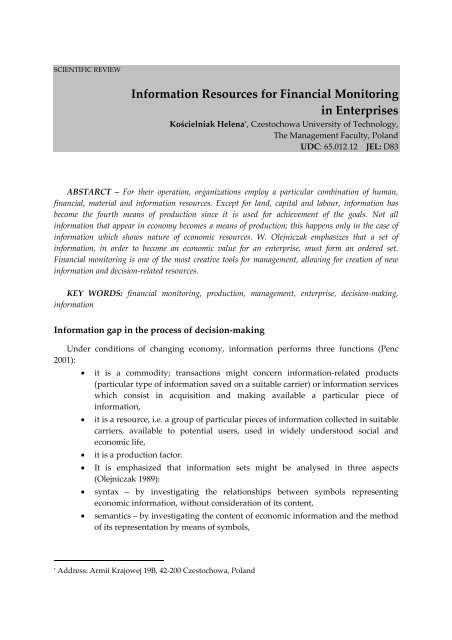Twice a Year Scientific Journal
Twice a Year Scientific Journal
Twice a Year Scientific Journal
You also want an ePaper? Increase the reach of your titles
YUMPU automatically turns print PDFs into web optimized ePapers that Google loves.
SCIENTIFIC REVIEW<br />
Information Resources for Financial Monitoring<br />
in Enterprises<br />
Kościelniak Helena * , Czestochowa University of Technology,<br />
The Management Faculty, Poland<br />
UDC: 65.012.12 JEL: D83<br />
ABSTARCT – For their operation, organizations employ a particular combination of human,<br />
financial, material and information resources. Except for land, capital and labour, information has<br />
become the fourth means of production since it is used for achievement of the goals. Not all<br />
information that appear in economy becomes a means of production; this happens only in the case of<br />
information which shows nature of economic resources. W. Olejniczak emphasizes that a set of<br />
information, in order to become an economic value for an enterprise, must form an ordered set.<br />
Financial monitoring is one of the most creative tools for management, allowing for creation of new<br />
information and decision-related resources.<br />
KEY WORDS: financial monitoring, production, management, enterprise, decision-making,<br />
information<br />
Information gap in the process of decision-making<br />
Under conditions of changing economy, information performs three functions (Penc<br />
2001):<br />
• it is a commodity; transactions might concern information-related products<br />
(particular type of information saved on a suitable carrier) or information services<br />
which consist in acquisition and making available a particular piece of<br />
information,<br />
• it is a resource, i.e. a group of particular pieces of information collected in suitable<br />
carriers, available to potential users, used in widely understood social and<br />
economic life,<br />
• it is a production factor.<br />
• It is emphasized that information sets might be analysed in three aspects<br />
(Olejniczak 1989):<br />
• syntax – by investigating the relationships between symbols representing<br />
economic information, without consideration of its content,<br />
• semantics – by investigating the content of economic information and the method<br />
of its representation by means of symbols,<br />
*<br />
Address: Armii Krajowej 19B, 42-200 Czestochowa, Poland
















